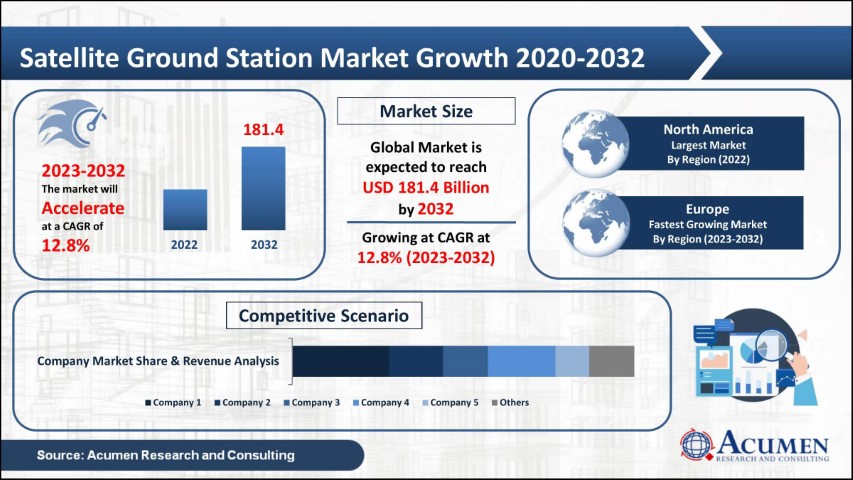Trends in the Satellite Ground Segment Market by Elisabeth Tweedie
by Elisabeth Tweedie
Los Angeles, Calif., March 15, 2024-In recent years the satellite industry has undergone a profound change–and one that is still continuing. High Throughput Satellites (HTS) have been joined by Very- and Ultra-High Throughput Satellites (VHTS and UHTS), and more recently by software defined satellites. Thousands of Non-Geostationary Orbit (NGSO) satellites are in operation. At the same time, new applications are constantly emerging. In-orbit Servicing (IoS) is a reality and Space Situational Awareness (SSA) is becoming a necessity, the Internet-of-Things (IoT) extends its reach on a daily basis. The range of frequency bands in regular use is expanding. L, C, Ku and Ka-bands are being joined by greater use of S, X and now V-band. Space tourism is a reality and in the next few years there will be satellites orbiting the moon, as well as earth.
None of this would be possible, were it not for a rapidly evolving and growing ground segment. According to Acumen Research, the Ground Segment will experience an impressive compound annual growth rate (CAGR) of 12.8% to reach US$181.4 Billion in the ten years to 2032.
Key Trends Driving Increased Utilization of Ground Services:
NGSO Constellations and Multi-orbit Networks
In 2022 Low Earth Orbit (LEO) constellations accounted for 52% of ground segment revenue, but this is likely to increase rapidly. Euroconsult predicts that by 2026, 90% of available in-orbit capacity will come from NGSO satellites. By definition communicating with satellites that are passing rapidly overhead, is far more complex than communicating with a GEO satellite. Constellations therefore demand far more from the ground system. They need complex traffic management systems, flexible beam allocation, load balancing and tracking antennas. As if this wasn’t enough, in order to deliver committed Service-level Agreements (SLAs), switching between orbits and frequencies is also a requirement for some customers.
IoT Evolution
The Internet of Things (IoT) continues to experience rapid growth. The number of connected devices is expected to reach 29 Billion by 2027, up from 14.3 Billion in 2022. Applications range from security and surveillance, to automation and smart meters, and most importantly for satellite, tracking applications; everything from shipping containers to cows. Things that roam into areas where there is no terrestrial coverage. This segment also encompasses offshore, maritime and aeronautical applications, where remote devices are used to monitor equipment and automate processes.
5G
The development of the 5G cellular standard, marks the first time that the satellite industry was invited to participate in the creation of a terrestrial standard. As a result, satellite is integrated into the standard. Ultimately, this interoperability will facilitate the expansion of voice over satellite, and already data communication direct to the cellular device (D2D) is occurring. Some have referred to this as “the largest opportunity in Satcom’s history.”
Increasing International Tensions and Military Conflicts
As international tensions escalate, so does the demand for communications and surveillance by governments and militaries around the world.
Evolution of the Ground Segment to Accommodate Growth:
New Technologies
As the barriers to entry are lowered and new applications and users emerge, so data usage grows. According to Euroconsult by 2031 revenue from data services will account for 42% of total satellite revenue, up from 15% in 2021. In order to cope with this increase in volume and the accompanying complexity of data processing, there is an increasing need for new technologies including automation, machine learning (ML) and artificial intelligence (AI). Among other things, these provide real-time detection of anomalies, predictive maintenance and problem detection, and more efficient use of resources, so optimizing performance and reliability.
Tracking and Phased-Array Antennas
Demand for these is increasing, as they are a necessity for both the NGSO constellations and also for maritime, aeronautical and land mobile applications whether these are communicating with a GEO or NGSO satellite. Phased-array antennas offer the advantages of dynamic beam forming for improved signal quality and communication with multiple satellites simultaneously.
Shifting Frequency Bands
Whilst the use of Ka-band is expanding for communication satellites, earth Observation (EO) satellites often use S and X bands for remote sensing and research applications.
RF over IP
This is growing rapidly, it enables more cost-effective distribution of RF signals over greater distances, with minimal signal loss. This reduces the complexity of the ground infrastructure, removing the need for all processing to be carried out in the same location as the physical antennas. It also permits greater geographical diversity of antennas, providing remote backup in the case of weather outages, whilst only requiring one data center, which could be a virtual one.
 |
Software Defined Ground Stations
While most service providers still rely on physical hardware for ground operations, there is an increasing trend towards virtualization of the ground, moving all or part of the infrastructure into the cloud.
The software defined ground station is more flexible and able to seamlessly switch between applications, satellites and frequency bands. It is also more scalable, allowing an operator to grow in-line with demand.
Standardization
At one time every hub manufacturer utilized its own proprietary standards. Not only did this mean that integration with terrestrial telecoms was more difficult, it essentially locked a user into one manufacturer. This is no longer the case as manufacturers are adopting common telecom standards. This is clearly shown by the Digital Intermediate Frequency Interoperability (DIFI) Consortium. Formed in late 2021, to enable the digital transformation of space, satellite, and related industries by providing a simple, open, interoperable Digital IF/RF standard, DIFI now has over 60 members.
Smaller, Portable Hardware
The manufacture of smaller, cheaper equipment that incorporates more efficient waveforms, processing techniques and coding, is both a response to, and a driver, for increased utilization of ground systems.
Ground-Station-as-a-Service (GSaaS)
This is a particularly attractive option to global operators needing a corresponding ground infrastructure. EO and IoT in particular, where the relatively low data rates and contact time per satellite, don’t justify the investment in a traditional owned and operated ground network. Offering GSaaS to those operators, enables them to move the expenditure from CAPEX to OPEX, lowering the upfront investment, reducing risk and allowing them to scale their operations in-line with demand.
Managing Ground Systems Complexity
The ground segment is undergoing a profound transformation, driven by increased demand and the growth in NGSO constellations in particular.
Ground stations are complex. They need antennas, modems, hubs, switches, routers, receivers and transmitters, encoders, network management systems, amplifiers, filters, transceivers and many other components. All of which have to work in perfect harmony, to provide the service required.
An operator could go alone and spend the time and money creating their own system, and dealing with different manufacturers; something that can become a major headache when something goes wrong and it isn’t immediately clear where the fault originated. It is certainly a time-consuming and labor-intensive task when designing a new end-to-end system.
Alternatively, they could work with an experienced and reputable Systems Integrator, such as Orbital Connect. Not only does this mean that there is only one supplier to deal with, and “one throat to choke” if a fault occurs, most importantly, it means that an experienced vendor, familiar with multiple manufacturers’ equipment can design an end-to-end system specifically tailored to an operator’s needs.
Orbital Connect
Orbital Connect’s product range includes over 3,000 satellite and RF components including Earth stations antennas, fixed and on-the-move and on-the-pause terminals and VSATs, receive-only antennas, high-power amplifiers, DVB modulators, demodulators, satellite modems, encoders, decoders, RF products and matrices, RF over fiber solutions, LNBs, BUCs, BDCs and LNAs. Orbital Connect’s website has a very user-friendly store listing all the products they represent: https://store.orbitalconnect.com/ It’s a one-stop shop online store where you can order the products directly online.
|
The Orbital Connect team, have expertise in cutting-edge satellite connectivity services over diverse frequency bands, seamlessly connecting satellites from multiple operators.
It is an authorized distributor and reseller for over 20 leading RF equipment manufacturers well-known service providers and satellite operators. These partners are carefully selected from leading players in their segments and include: Speedcast, Inmarsat, Intelsat, IABG Teleports, MetOcean, Globalstar, ST Engineering iDirect, Norsat, Terrasat, Intellian, Cobham, CPI, Kymeta, C-Com, ETL Systems, Sat-Lite, Media Kind, Comtech, Profen, Spacebridge, Peplink, and many more.
These companies, in common with Orbital Connect, are proud of their reputations, therefore a company wanting to qualify as distributor, has to meet the stringent requirements, before being accepted as a partner. Orbital Connect’s customers, can therefore feel confident that not only does Orbital Connect hold itself to the highest standards, because of its relationship with so many vendors, it also has very broad expertise in ground systems, and knows precisely how to put together an end-to-end solution tailored to each customer’s needs. Regardless of whether the requirement is for a mesh, star or hubless system; whether Starlink or cellular channel bonding is needed; whether communication is to one satellite or multiple satellites; whether the system is to be hardware based or in the Cloud, Orbital Connect has the experience and expertise to build a cost-effective end-to-end system.
Designing, specifying and installing a system is important, so too is being able to maintain that system and deal with any issues that arise during the course of normal operations. Orbital Connect, is your one-stop shop. It maintains a global support network of partners to meet even the need of most demanding customers.
Customers
Orbital Connect has expertise and customers in many key sectors, including: Broadcasting, Energy, Enterprise, Government, Maritime, NGO/Aid, Science and Education, Telecom and Transportation. It is not afraid to tackle the hardest challenges. For example, it worked with Intellian to provide the Bulgarian Naval Academy “always-on” connectivity in the most remote and extreme environment: The Antarctic and Livingstone Island (located at 62oS).
Orbital Connect is proud to count amongst its customers leading players in Satcom, Telecom and Broadcasting including: Intelsat, Aerospace Corporation, Globecast Americas, L3 Harris, Northrop Grumman, OHB Sweden, Raytheon, U.S. Navy, University of San Diego, U.S. Agency for Global Media, John Hopkins APL and the Bulgarian Antarctic Union. Clients from the scientific and aerospace fields frequently approach Orbital Connect, seeking customized solutions. These requests typically consist of specific technical parameters or innovative solutions to facilitate communication with LEO constellations for research purposes.
Looking to the Future
As already mentioned, LEO satellites whether for communication or EO, are projected to account for the majority of ground service revenue in the future. This means far greater demand for electronically steered antennas (ESAs) and associated RF components. Orbital Connect is keeping on top of this trend and the accompanying demand for customization in multiple sectors, including Maritime, Government, Transportation and Scientific Establishments.
For example, an aerospace client recently approached Orbital Connect to design and supply customized RF components for specific S and X-band frequency ranges and precise temperature tolerance, to enable a reliable ground to LEO satellite interface. It was able to supply this client with all the needed equipment and fully integrate this into the client’s existing ground system.
In another example, there was a specific request for Ku- and Ka-band ESAs for scientific trials for an integrated network communicating with both LEO and GEO satellites. Again, it was able to satisfy the request and design a suitable system.
“...The tremendous opportunities presented by LEO orbit utilization and solutions stimulate a boom in the satellite industry, driving a trend to involve more critical thinkers and resourceful solution seekers in the process...”
These were not simple requests. Addressing complex needs such as these, requires in-depth knowledge of phased-array technology, RF product specifications, applications and available configurations. This is made all the more challenging by the speed at which technology is advancing and new products are being introduced.
 |
| To read or download the full MarketBrief report on Ground Systems, click here. |
In today’s world, to successfully finalize deals, a ground station equipment distributor increasingly relies on the participation of an engineering team and collaboration between vendors, clients, and sometimes third parties. The tremendous opportunities presented by LEO orbit utilization and solutions stimulate a boom in the satellite industry, driving a trend to involve more critical thinkers and resourceful solution seekers in the process.
It is therefore essential that any supplier needs to be fully aware, not only of what is available, but also of what will be available in the near future. To make sure that it is fully abreast of the latest technology and trends, Orbital Connect works closely with its vendors and prioritizes facilitating first-line communication between clients and vendor technical teams.
More challenging projects, such as lunar orbit and deep space endeavors will require collaborating with the best available talent to develop appropriate solutions. The close association that Orbital Connect already has with its vendors, coupled with its team’s deep technical expertise, means that it is ready to address these challenges and any others that the future may bring.
-----------------------------------------------------
 Elisabeth Tweedie is Associate Editor of the Satellite Executive Briefing has over 20 years experience at the cutting edge of new commmunications entertainment technologies. She is the founder and President of Definitive Direction (www.definitivedirection.com), a consultancy that focuses on researching and evaluating the long-term potential for new ventures, initiating their development, and identifying and developing appropriate alliances. She can be reached at: etweedie@definitivedirection.com
Elisabeth Tweedie is Associate Editor of the Satellite Executive Briefing has over 20 years experience at the cutting edge of new commmunications entertainment technologies. She is the founder and President of Definitive Direction (www.definitivedirection.com), a consultancy that focuses on researching and evaluating the long-term potential for new ventures, initiating their development, and identifying and developing appropriate alliances. She can be reached at: etweedie@definitivedirection.com





